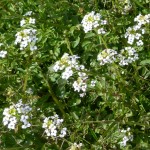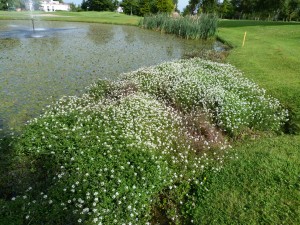Water Cress
Latin: Nasturtium officinale
Irish: Biolar
This is a native perennial, with small white flowers that appear in June, and with creeping stems that root in mud in shallow streams and at the edges of ponds. It occurs profusely at the edges of lakes on the course at Castlewarden and is very visible and accessible around the lake on the right side of the 3rd green.
This plant has a peppery taste and can be used in salads and is said to contain significant amounts of iron, calcium, folic acid, Vitamins A and C. However, plants coming from stagnant water or where sheep graze should not be eaten because they may carry liver fluke or other harmful parasites.
The term “officinale” comes from the Latin meaning “sold in apothecaries shops” signifying that it has a history of being used in medicine. The 16th century herbalist John Gerard recommended Water Cress as a cure for scurvy and it was used in sailors’ diets when away for long voyages.
One of the healing potions used by Biddy Early (1798-1874), the famous herbalist from Feakle, Co. Clare, was a remedy for swollen limbs. It was a poultice of water cress, cabbage and nettles bound up in eggwhite.
Some authorities classify this plant as a member of the Rorippa genus but most now assign it to the Nasturtium genus. This is the generic name of a group of perennials that grow in wet places. The garden flowers of the same name are quite unrelated – their botanical name is Tropaeolum.

